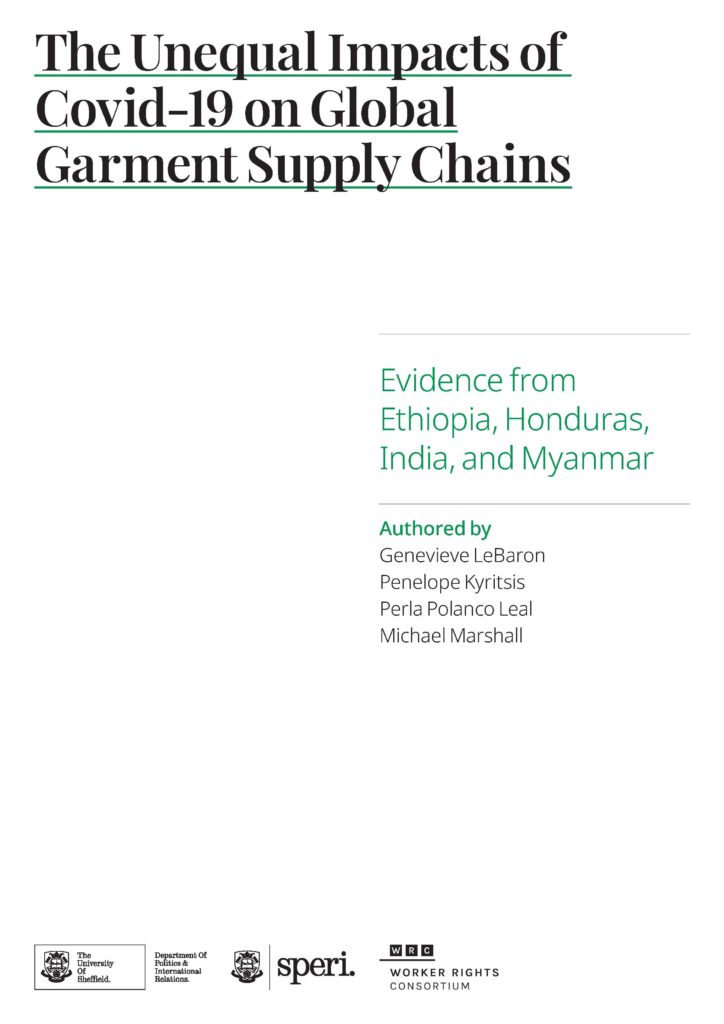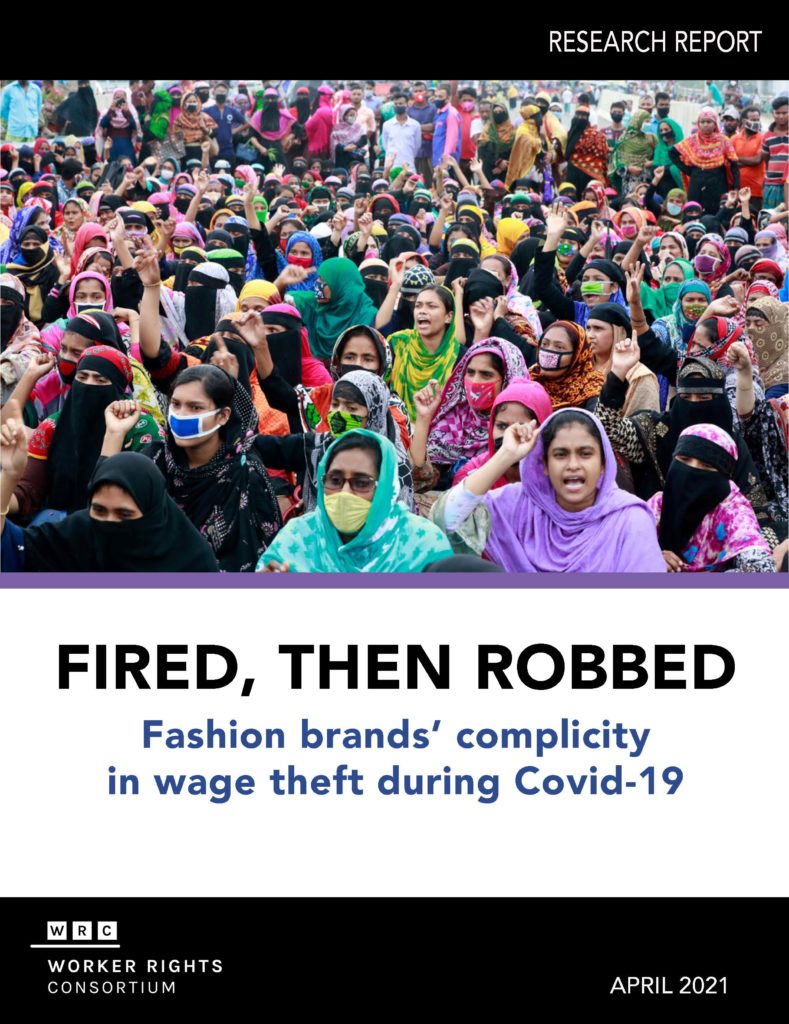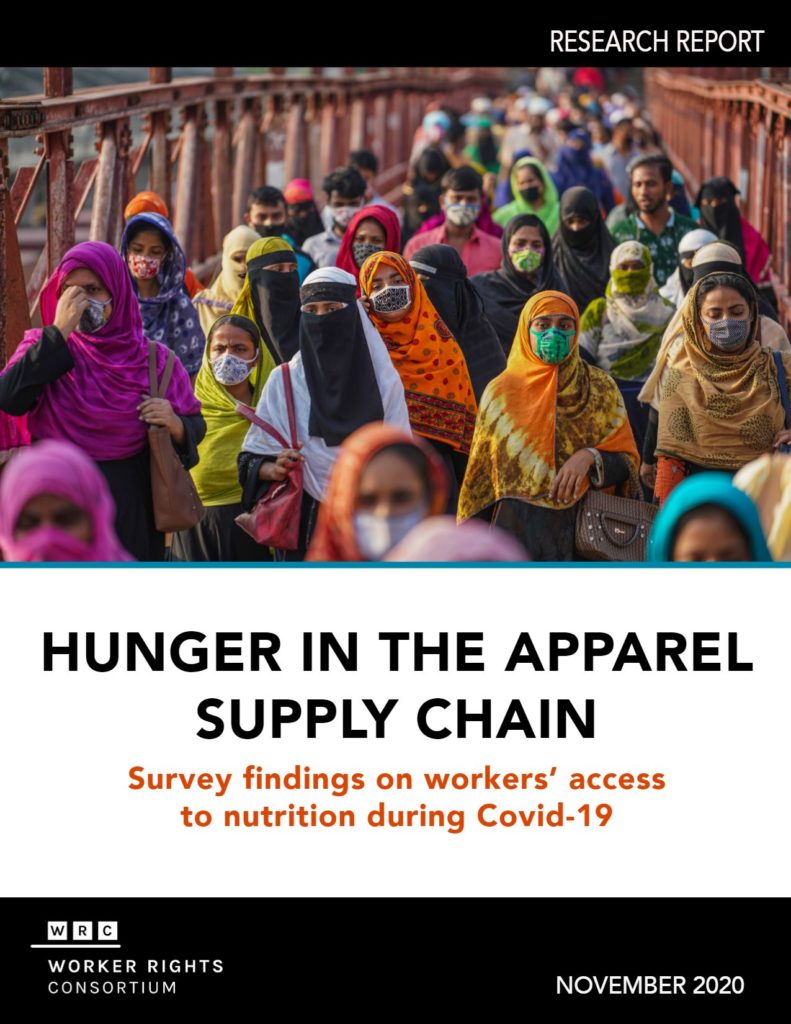Push to ‘Pay Up’ Stops Brands from Stealing Billions during Pandemic
The garment workers who make the clothes we wear were among the hardest hit by the economic catastrophe of Covid-19. Long-standing inequities in global apparel supply chains—from one-sided contracts that allow brands to cancel clothing orders their suppliers have already produced, to chronically low wages in factories producing for the world’s most lucrative apparel labels—made garment workers exceedingly vulnerable to the economic shocks of the Covid-19 pandemic.
As the virus, and government efforts to combat it, upended the global economy, garment factories around the world were hit by an estimated total of $40 billion in retroactive order cancellations by international brands (in other words, refusing to pay for clothing suppliers had already produced or were producing), as well as huge reductions in new orders. The result was widespread factory closures and mass layoffs, with myriad cases of nonpayment of legally mandated wages and severance. In effect, the actions of apparel brands and their suppliers pushed a disproportionate share of the pandemic pain onto the backs of workers.
The WRC led efforts to expose the malfeasance and press brands to pay. In coordination with other labor rights advocacy groups, we helped restore $22 billion in payments from brands to suppliers, including hundreds of millions for workers’ wages. These achievements created a precedent that has already helped stave off the worst consequences for textile and garment workers in other crises: for example, in the aftermath of the earthquake that hit southeastern Türkiye in February 2023, brands allowed for delivery delays without demanding discounts from their suppliers, and, when widespread civil society protests erupted in Bangladesh in July and August 2024 with hundreds of factories closing for several days, brands ensured their suppliers paid workers in full for those days and did not impose penalties for delivery delays.
While the WRC along with unions and other labor rights advocates accomplished much to staunch the worst economic impacts of the Covid-19 crisis, neither governments of wealthy nations nor the apparel brands that have long benefited from cheap labor took the initiative to step up to assist workers in manufacturing supply chains. The economic fallout of Covid-19, as demonstrated in the reports below, exacerbated existing inequities within global supply chains and revealed a production system that is badly broken—in terms of equity, labor rights compliance, and economic resilience. The need for fundamental reform has never been clearer.
Updated: Guidelines for Effective Covid-19 Infection Control Practices and Policies at Operating Apparel and Textile Factories
The WRC and occupational health experts from the Maquiladora Health and Safety Support Network (MHSSN) and Alliance Consulting International have developed recommendations for protecting garment workers from transmission of Covid-19 in factories that are in operation during the pandemic.
 Worker Rights Consortium Guidelines for Workers’ Compensation for Workers at Garment Factories Who Contract Covid-19
Worker Rights Consortium Guidelines for Workers’ Compensation for Workers at Garment Factories Who Contract Covid-19
In the face of countless outbreaks of the Covid-19 illness in factories and other workplaces around the world, exposure to SARS-CoV-2 is increasingly recognized by governments and health professionals as an occupational hazard facing workers and employers in all industrial sectors, including garment manufacturing. This document provides guidance for apparel brands and their supplier factories with respect to compensation for workers who contract Covid-19.
The Unequal Impacts of Covid-19 on Global Garment Supply Chains
We find that garment workers’ labour and living conditions have severely worsened during the pandemic and workers are experiencing severe economic hardship and labour abuse. Across all four of our case study countries, workers have experienced sharp declines in earnings and working conditions, including increased vulnerability to key indicators of forced labour.
These dynamics are evident for workers who have remained in the same jobs with no change in their employment status, as well for those who have had their contracts terminated amidst the pandemic and found new jobs; which have often involved worse working conditions and lower pay compared to their pre-pandemic employment. These patterns varied across case study country; individual level factors such as age, gender, race and ethnicity, union affiliation, migration and employment status; and commercial dynamics in supply chains.
 Fired, Then Robbed: Fashion brands’ complicity in wage theft during Covid-19
Fired, Then Robbed: Fashion brands’ complicity in wage theft during Covid-19
Tens of thousands of garment workers at factories producing for leading fashion brands, who were fired during the Covid-19 pandemic, are being denied terminal compensation, in violation of the law and the labor rights obligations of the brands and retailers whose clothes they sewed. This research report exposes severance pay theft at dozens of factories, all named in the report, where workers were robbed of an average of more than a thousand dollars (US) per person.
The WRC’s data represent a modest fraction of the factory closures in the industry, indicating that the severance theft the report reveals is the tip of the iceberg. The WRC estimates that the millions of garment workers terminated globally during the pandemic have been robbed of more than half a billion dollars in earnings since the pandemic's outset.
 Hunger in the Apparel Supply Chain: Survey findings on workers’ access to nutrition during Covid-19
Hunger in the Apparel Supply Chain: Survey findings on workers’ access to nutrition during Covid-19
This research report presents new data about how garment workers’ food security—and linked dynamics of employment status and income—has deteriorated amidst the pandemic. Our data reveal an alarming pattern: garment workers’ declining incomes are leading to widespread hunger among workers and their families, as they are increasingly unable to obtain adequate food and nutrition. These dynamics are a direct result of apparel brands’ responses to the Covid-19 pandemic, as well as the long-term trend of low wages for garment workers in brands’ supply chains, which has left workers unprotected.
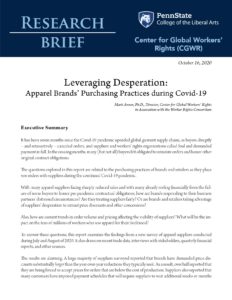 Leveraging Desperation: Apparel Brands’ Purchasing Practices during Covid-19
Leveraging Desperation: Apparel Brands’ Purchasing Practices during Covid-19
A July – August survey of 75 garment suppliers in 15 countries reveals shocking changes in brands' pricing and purchasing practices on new orders. The report finds that brands are using suppliers’ pandemic-driven desperation as leverage to drive down prices and impose onerous payment schedules on new orders they are placing. Many suppliers are being forced to accept orders below cost, potentially forcing them out of business and putting workers' livelihoods at risk.
 Unpaid Billions: Trade Data Show Apparel Order Volume and Prices Plummeted through June, Driven by Brands’ Refusal to Pay for Goods They Asked Suppliers to Make
Unpaid Billions: Trade Data Show Apparel Order Volume and Prices Plummeted through June, Driven by Brands’ Refusal to Pay for Goods They Asked Suppliers to Make
US and EU trade data provide considerable evidence of a significant loss in value due to order cancellations. A total of USD 16.2 billion was lost, combined, from April through June in the US and from April through May in the EU (a number that will almost certainly increase when June data are available for the EU). Assuming that wages make up 10 percent of the value (at import price), what this suggests is the loss of close to USD 2 billion in workers’ wages, based on reduced imports for the US and EU markets alone.
During Pandemic, Universities Continue Support of Living-Wage Jobs
Despite the tremendous challenges facing colleges and universities during this back-to-school season, dozens of schools have chosen to leverage their mask procurement and licensing choices to support living-wage jobs by sourcing from Alta Gracia Apparel.
University support of Alta Gracia’s move into mask production this spring has been crucial in maintaining the factory’s ability to continue providing living-wage jobs to Dominican workers. University of Connecticut and Georgetown University are among the schools that have procured significant numbers of masks for use by the campus community from Alta Gracia. Notre Dame, University of Florida, and a number of other WRC affiliates have also supported Alta Gracia through mask procurement and licensing.
 Farce majeure: How global apparel brands are using the Covid-19 pandemic to stiff suppliers and abandon workers
Farce majeure: How global apparel brands are using the Covid-19 pandemic to stiff suppliers and abandon workers
This paper by the European Center for Constitutional and Human Rights, ILAW, and the Worker Rights Consortium explores the power imbalances between brands and suppliers and their contractual manifestation. It examines the law of force majeure and related doctrines and how they apply to the current circumstances. The paper explains how brands violate their due diligence obligations through canceling orders. It also calls for better access to accountability mechanisms for workers to enforce brands’ responsible supply chain practices.
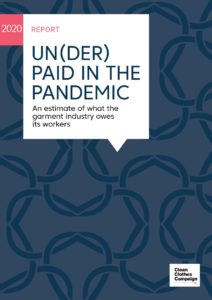 Un(der)paid in the Pandemic
Un(der)paid in the Pandemic
This report analyses nonpayment of wages to garment workers during the months of March, April, and May resulting from order cancellations by apparel brands, unpaid leave, and state-sanctioned wage cuts during the Covid-19 crisis. Based on a review of news reports and information from worker organizations, we estimate that across South and Southeast Asia garment workers have received 38% less than their regular income. In some regions in India, this number rises above 50%. Extrapolating these findings to the global garment industry, a conservative guess of wages lost by garment workers worldwide, excluding China, for the months of March, April, and May would amount to between 3.19 and 5.79 billion USD.
 "My children don't have food. I can withstand this hunger, but they cannot." What the Crisis Means for the People Who Make Collegiate Apparel
"My children don't have food. I can withstand this hunger, but they cannot." What the Crisis Means for the People Who Make Collegiate Apparel
The pandemic represents an unprecedented economic calamity for workers who make university logo products. Across the globe, factories have suspended or dismissed workers in the hundreds and thousands, often with little or no compensation. This includes many factories making collegiate goods. This report includes portraits of six workers at collegiate factories, drawing on workers’ own words to illuminate the impact on their families. Most of these workers are no longer able to buy sufficient food for their children.
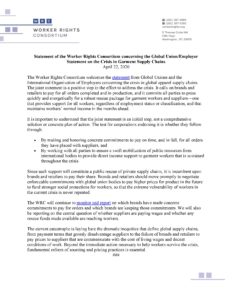 Statement of the Worker Rights Consortium concerning the Global Union/Employer Statement on the Crisis in Garment Supply Chains
Statement of the Worker Rights Consortium concerning the Global Union/Employer Statement on the Crisis in Garment Supply Chains
The joint statement from Global Unions and the International Organisation of Employers calls on brands and retailers to pay for all orders completed and in production, and it commits all parties to press quickly and energetically for a robust rescue package for garment workers and suppliers. The WRC welcomes this as an initial step and will continue to monitor and report on which brands have made concrete commitments to pay for orders and which brands are keeping those commitments. The WRC cautions that this is not a comprehensive solution or concrete plan of action, what matters is how and whether brands follow through.
 What Are Factories' and Brands' Responsibilities to Laid-Off Workers?
What Are Factories' and Brands' Responsibilities to Laid-Off Workers?
Brands have committed through their codes of conduct to require suppliers to pay workers legally owed compensation when factories shutdown. Workers’ ability to get their families through the current crisis will depend substantially on whether brands make sure suppliers pay laid-off workers their legally due compensation. The WRC has compiled a detailed summary of these legal requirements in major apparel exporting countries, as well as changes to these obligations under new laws or policies enacted by governments in response to the crisis.
 Abandoned? The Impact of Covid-19 on Workers and Businesses at the Bottom of Global Garment Supply Chains
Abandoned? The Impact of Covid-19 on Workers and Businesses at the Bottom of Global Garment Supply Chains
This report, authored by Pennsylvania State University’s Center for Global Workers’ Rights, in collaboration with the WRC describes the results of a survey of more than 300 garment suppliers in Bangladesh and has just reported the results. The survey found that 80 percent of apparel suppliers have been forced to slash employment as a result of buyers canceling orders—with nearly 60 percent reporting they have shut down most or all of their operations. Meanwhile, four out of five fired workers have not received the severance pay mandated by law. The survey found that almost none of the buyers had offered suppliers any financial support to help pay workers.
 WRC WHITE PAPER: Who will bail out the workers that make our clothes?
WRC WHITE PAPER: Who will bail out the workers that make our clothes?
Co-authored by WRC executive director Scott Nova and the CCC’s Ineke Zeldenrust, this white paper explains how brands and retailers are shoring up their own finances by refusing to honor contracts with apparel suppliers, forcing suppliers to the brink of bankruptcy and causing large-scale dismissals of workers. The report calls for brands to pay suppliers what they owe them, for the swift mobilization of international financial resources to provide income support to garment workers, and for deeper reforms to address the supply chain inequities that Covid-19 is laying bare.
CCC Live-blog: How the Coronavirus affects garment workers in supply chains
This live-blog by the Clean Clothes Campaign aims to collect daily information about how Covid-19 is affecting garment workers’ rights in supply chains around the world. It will be updated as new information comes in from media and the Clean Clothes Campaign global network. Information is posted as it comes in from the network and cannot always be double-checked.

